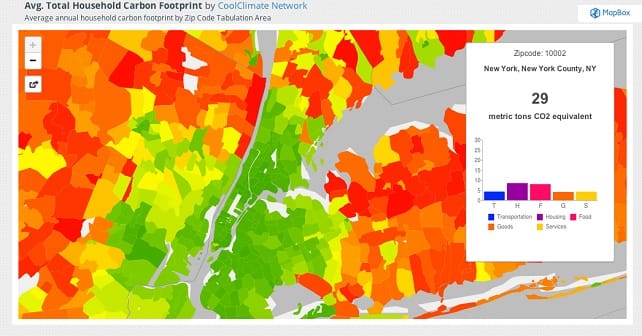High-carbon suburbs drag down city climate efforts

Densely populated big cities have earned a reputation for being energy- and carbon-efficient places to live.
Unfortunately, the sprawling suburbs that typically surround those cities pretty much cancel out those benefits.
In fact, US suburbs — while accounting for less than half the country’s population — generate half of all the nation’s greenhouse gas emissions, researchers at the University of California-Berkeley have found.
“Metropolitan areas look like carbon footprint hurricanes, with dark green, low-carbon urban cores surrounded by red, high-carbon suburbs,” said Christopher Jones, a doctoral student who works in the university’s Energy and Resources Group. “Unfortunately, while the most populous metropolitan areas tend to have the lowest carbon footprint centers, they also tend to have the most extensive high-carbon footprint suburbs.”
The result is that large metropolitan areas, when you factor in their suburban as well as urban inhabitants, have carbon footprints that are slightly higher on average than those for smaller cities.
“A number of cities nationwide have developed exceptionally interesting and thoughtful sustainability plans, many of them very innovative,” said Daniel Kammen, director of Berkeley’s Renewable and Appropriate Energy Laboratory. “The challenge, however, is to reduce overall emissions … Cities are not islands: they exist in a complex landscape that we need to understand better both theoretically and empirically.”
Kammen and Jones found that the factors most likely to affect the size of an area’s carbon footprint are household income, vehicle ownership and home size. As a result, more population-dense suburbs aren’t necessarily more carbon-efficient … because their higher incomes tend to lead to greater consumption.
The greatest sources of carbon can differ widely, though, from one region to another. California, for instance, has relatively low emissions from household electricity use, while the opposite can hold true in parts of the Midwest that are heavily dependent on coal power.
This means that climate solutions need to be tailored to an individual area’s specific circumstances and demographics.
“Suburbs are excellent candidates for a combination of solar photovoltaic systems, electric vehicles and energy-efficient technologies,” said Kammen. “When you package low-carbon technologies together you find real financial savings and big social and environmental benefits.”
Kammen and Jones say cities need to step out of traditional roles in planning urban infrastructure and learn how to better understand the needs of residents. They’re currently running a competition, the CoolCalifornia Challenge, that encourages participating cities to create individualized, targeted strategies for motivating citizens to take climate action.




